Race relations at The George Washington University reveal an
advertisement
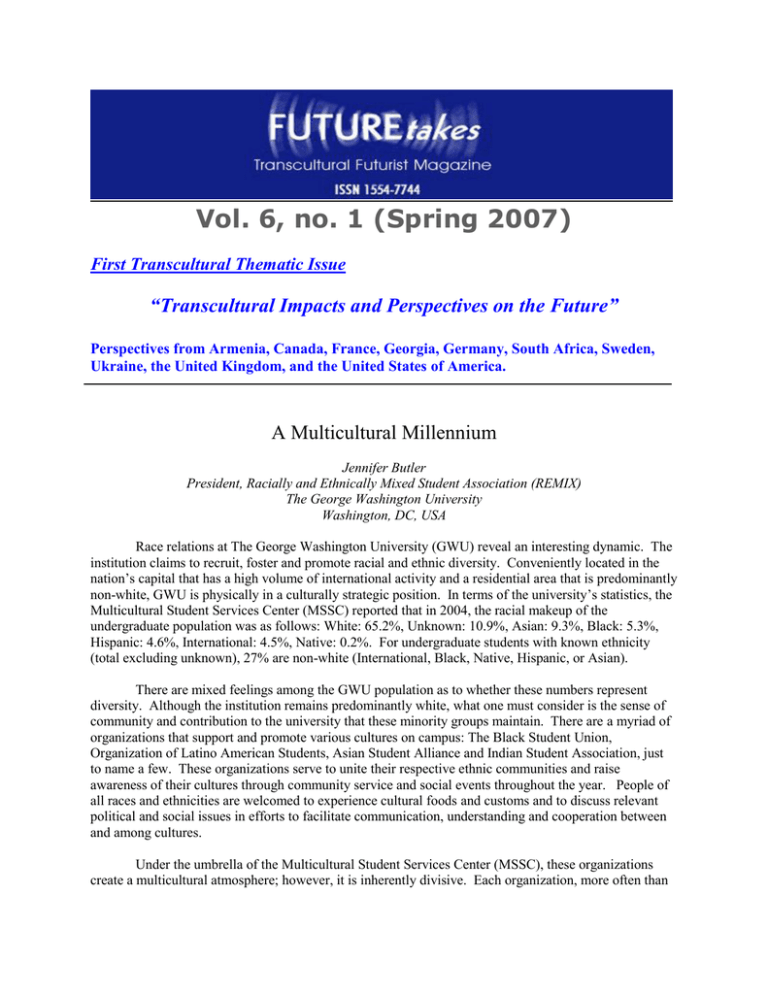
Vol. 6, no. 1 (Spring 2007) First Transcultural Thematic Issue “Transcultural Impacts and Perspectives on the Future” Perspectives from Armenia, Canada, France, Georgia, Germany, South Africa, Sweden, Ukraine, the United Kingdom, and the United States of America. A Multicultural Millennium Jennifer Butler President, Racially and Ethnically Mixed Student Association (REMIX) The George Washington University Washington, DC, USA Race relations at The George Washington University (GWU) reveal an interesting dynamic. The institution claims to recruit, foster and promote racial and ethnic diversity. Conveniently located in the nation’s capital that has a high volume of international activity and a residential area that is predominantly non-white, GWU is physically in a culturally strategic position. In terms of the university’s statistics, the Multicultural Student Services Center (MSSC) reported that in 2004, the racial makeup of the undergraduate population was as follows: White: 65.2%, Unknown: 10.9%, Asian: 9.3%, Black: 5.3%, Hispanic: 4.6%, International: 4.5%, Native: 0.2%. For undergraduate students with known ethnicity (total excluding unknown), 27% are non-white (International, Black, Native, Hispanic, or Asian). There are mixed feelings among the GWU population as to whether these numbers represent diversity. Although the institution remains predominantly white, what one must consider is the sense of community and contribution to the university that these minority groups maintain. There are a myriad of organizations that support and promote various cultures on campus: The Black Student Union, Organization of Latino American Students, Asian Student Alliance and Indian Student Association, just to name a few. These organizations serve to unite their respective ethnic communities and raise awareness of their cultures through community service and social events throughout the year. People of all races and ethnicities are welcomed to experience cultural foods and customs and to discuss relevant political and social issues in efforts to facilitate communication, understanding and cooperation between and among cultures. Under the umbrella of the Multicultural Student Services Center (MSSC), these organizations create a multicultural atmosphere; however, it is inherently divisive. Each organization, more often than FUTUREtakes Vol. 6, No. 1 Spring 2007 not, acts exclusively within their own racial group, rarely working with other organizations. At the same time, there is another population that belongs to the multicultural community: those who are of mixed race backgrounds. Many of these students who identify themselves as such do not feel comfortable in racially monotonous settings, as their cultural pride is more ambiguous. A liaison organization was clearly needed, not only to bridge the gap between and among the cultural organizations at GWU, but also to accommodate those students who physically embody the result of racial harmony. The traditions of a dichotomous society fail to fulfill the needs of the entire population; in an environment that claims multiculturalism, GWU lent itself as an appropriate arena for a new organization to support this category of people. ENTER REMIX Two biracial GWU students acknowledged this large and unrepresented group of students and with that, co-founded the Racially and Ethnically Mixed Student Association (REMIX). The George Washington University was the twelfth school in the United States to sponsor a multiracial student group such as REMIX on campus. Although a progressive and seemingly simple solution to the “please check one” mentality, it is difficult to unite a group of students with so much diversity. However, as individuals share experiences, trade ideas and discuss issues, it becomes clear that we are united, not despite our differences, but because of them. Being multiracial in America renders a unique experience contingent upon the individual and one’s environment. The stereotypical identity crisis does not necessarily arise from internal confusion about one’s own heritage, but because of others’ fixation and need for a neat cultural classification. Therefore, society is prone to not only ask these individuals to identify with one race and not the other but also tell these individuals that they are one race and not the other. REMIX is a community dedicated to those individuals who live as a bridge between two worlds that they are not allowed to enter. It is a common ground for those who are asked, “What are you?” before asked, “What is your name?” REMIX is a place, one of few, where multiracial students can learn about themselves from each other. It is also a place to learn about the real dangers and real struggles that they face. The official REMIX mission is to build a community for multi-ethnic students at GWU; to provide a forum for multi-ethnic students to voice concerns or raise questions; and to promote awareness of the unique societal position of multi-ethnic individuals. Individuals of mixed racial and ethnic heritage have distinctive advantages, but they also experience particular challenges. Those who are socialized as multiracial frequently have an enhanced sense of self and of identity, and greater appreciation of minority group cultures as well as inter-group tolerance. At the same time, the development of such a positive, composite identity is difficult. Characteristics are contingent upon various societal pressures; socialization within the family, among friends, romantic interests and personal feelings regarding identity choices. Although this is one of the fastest growing ethnic minorities all over the nation, these pressures result in mixed race individuals as having some of the highest suicide rates and the highest rates of being physically and sexually abused. Prior restrictions of indicating only one race forced the denial of people’s true heritage. Failure to recognize one’s racial mixing is also a health concern, as the cure to diseases such as leukemia and other bone marrow ailments rely on donors with specific ethnicities. Seemingly minor identity issues give way far greater concerns of the multiracial population. If the group as a whole decides to remain silent, these problems will only get worse. REMIX is, above all, a voice for a group that has been ignored for too long. The lack of acceptance and understanding has led to an absence of identity and culture among multiethnic individuals, only to be cured by the creation of a community. All GWU students – mixed and otherwise – are encouraged to be involved and to help overall awareness of this underrepresented, yet substantial, populace. REMIX looks to achieve these goals by having monthly general body meetings and information sessions; hosting a variety of events; spreading the word through listservs and 2 FUTUREtakes Vol. 6, No. 1 Spring 2007 advertising; serving as a cultural liaison between and among all cultural student organizations; and creating a social support group. Celebrating multiracial pride is not necessarily a universal or uniform salute due to the variety of mixes and the atmosphere in which they have grown. Some individuals succumb to the convenience factor of being a social chameleon, conforming with respect to the majority of one’s environment; others maintain both (or all) cultural values they have inherited and celebrate the fact that they can equally trump all aspects that make them distinct from other minorities. THE NEW MULTIRACIAL IDENTITY The largest barrier that REMIX has encountered is the difficulty in defining membership and helping those who do not yet feel comfortable identifying themselves as multiracial to be involved. Other cultural organizations such as the Black Student Union and the Chinese American Student Association have obvious membership: those are Black and Chinese, respectively, are automatically and obviously welcome members to the group. To be racially and/or ethnically mixed, however, includes so many different combinations and identities that it is difficult to accommodate for all the diversity and to create a sense of unity. In efforts to deal with this obstacle, continuous effort and support is encouraged and solicited through co-sponsorships and active participation from the other student groups at GWU. REMIX serves not only to create a multicultural community but also to promote awareness of such mixed individuals. Therefore, membership is open to everyone and anyone who is interested in this population and its unique societal position. Additionally, to make students aware that they can have dual or multiple membership of any organization they wish alleviates the decision to choose between groups. Because of the organization’s constant promotion, mixed race is being increasingly recognized as a new and accepted racial category, evident through the production of more multicultural events on campus, more invitations to REMIX from other cultural orgs and an increased membership of the group. There is certainly more progress to be made, but what has been done is quite substantial. With the newly elected DC mayor, Adrian Fenty, and a high-profile 2008 U.S. Presidential candidate, Barak Obama – both of whom are biracial – REMIX intends to draw attention to multiracial public figures and provide inspiration to students of similar backgrounds. It is important to consider the image of multiracial individuals who are highly publicized and how they portray themselves compared to how they are portrayed by society. For example, Halle Berry was the first African-American actress to receive an Academy Award only five short years ago. Berry’s mother is, in fact, Caucasian; however, she is still, and most likely always will be, referred to as black. On the other hand, Tiger Woods – the multiracial poster child – has continued to correct society’s stubbornness to stamp him with a convenient label. Eager, and sometimes selectively ignorant, claims to his identity as simply African-American are rebuffed as he asserts his “Caublinasian” background – and rightly so. Embracing or rejecting certain labels appears to test one’s allegiance to the minority community, as names were inherently created to divide and separate individuals. Regardless, with acknowledging only a single aspect of one’s essence, the other is essentially erased. However, the future of racial classification lies in the extension of social boundaries and the denial of simply being a token representation at the convenience of others. A NATIONAL DEMOGRAPHIC SHIFT Mixed heritage people and families are not a novel phenomenon in the U.S. As early as 1641 there were laws that prohibited sex or marriage between races in the American colonies, laws that were upheld for over three centuries. The U.S. Supreme Court case Loving v. Virginia (1967) finally struck down all laws banning miscegenation. The first time that Americans were officially able to record their 3 FUTUREtakes Vol. 6, No. 1 Spring 2007 true mixed heritage was through the option of checking multiple boxes on Census 2000. About seven million people took advantage of this new classification, furnishing a more accurate reflection of the national demographic. One in every forty Americans was registered as belonging to two or more racial groups; sociologists predict that this ratio could soar to one in five Americans by the year 2025. And yet, despite this national mixed race baby boom, few people are aware of the unique needs of this rapidly growing community. Being able to choose a combination of up to six different categories of races, including “Other,” on the census indicates that people can now officially recognize the mixing of racial backgrounds in American society. With a continued increase in immigration and interracial marriage, the multiracial population is moving America far beyond the black and white dichotomy. Racial divisions may be weakening, but they are not irrelevant. New color lines may be emerging – the old black-white divide is being replaced with a new black- non-black sentiment. Yet and still, the lines are becoming harder to draw; the future of ethnicity as the source of identity will be based on the diversity of individuals as opposed to the diversity of groups. It is necessary to acknowledge that those two students who were able to channel their discomfort with the current social situation at their school created a pioneering organization. There are too many individuals who are silently being suppressed by racial pressures who are just looking for a means for change. It is crucial to maintain a peer support group among minorities to make sure that their unique perspectives and identity are not lost to societal pressure and assimilation. Part of the growth of this population is from a newfound willingness to report their multicultural backgrounds, which is a radical step considering the country’s historical context and the existence of the “one-drop rule.” There are major improvements needed in the individual and in the home; but through positive representations in the media, work place and school environment, the more personal problems will be less severe. In America, we are usually taught that change comes from within, but that does not mean anything if one does not have money or even the possibility of a successful career. Point being: socioeconomics also play a huge role in implementing certain programs and acquiring support. It is important to see how minorities view mixed people as well. Some civil rights groups did not advocate for more than one box on the census form due to concerns about potential loss in their memberships, reducing the effectiveness of programs aimed at helping minorities. Either way, it is a new perspective and a name that might draw people in. Mixed race individuals are neither new nor unique of The George Washington University or Washington, DC. There is a need for national recognition in the United States and for the acknowledgment and representation of multiracial heritage. An increasingly diverse composition reflects a clear and perpetual blending of races and shifting of color lines. The actions that the multicultural community takes today are pivotal because we are the physical embodiment of racial harmony. We are the microcosm of the future. POINTS FOR THE CLASSROOM (send comments to forum@futuretakes.org): o Butler foresees that “the future of ethnicity as a source of identity will be based on the diversity of individuals as opposed to the diversity of groups.” Do you agree, and if so, what are the implications? o What is the future of mixed race recognition and racial categorization? Will multi-ethnicity itself be a new source of identity – especially in this era of rapid change that motivates some people to cling to their “tribe” (ethnic group) for a sense of identity and stability? 4 FUTUREtakes Vol. 6, No. 1 Spring 2007 o What is the future of “us-them” dichotomization (counterpoint-based identity) that underlies ethnic, religious, and political strife today, and throughout history – and with what implications for partisan politics in the next decade? o Many people have referred to the US as a “melting pot” in which immigrants of various traditions and customs intermingle and lose their native cultures, at least in terms of their everyday experiences. Another descriptor, more recent, is the “salad bowl,” in which diverse cultures and ethnicities live amongst one another in harmony but maintain their individual identities. At the same time, the US has developed its own business culture and mainstream lifestyle (see other “points for the classroom,” this issue). What is the future of various cultural traditions, values, and lifestyles in the US and elsewhere? In addition, which will prevail in your part of the world in 2020 – cultural clashes, deculturation, or cultural diversity? o Butler’s article refers to socioeconomics. Will other cultures bring new “ladders of success” and concepts of prosperity that are alternatives to the mainstream US business culture – especially considering other long-term challenges to present ways of life (challenges that futurists are quick to point out)? 5
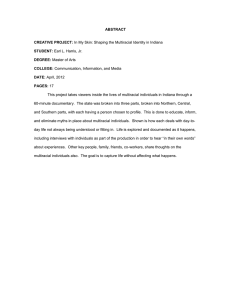
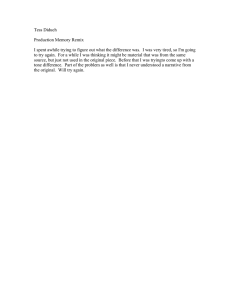
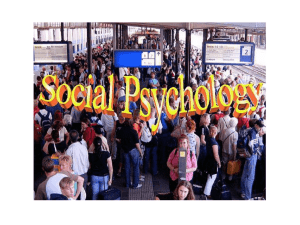
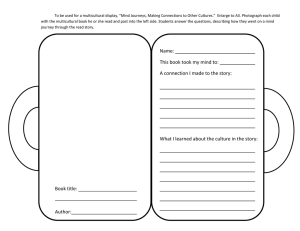
![[insert organizational header]](http://s3.studylib.net/store/data/007468113_1-a7a4132c2cccee9d2a64f31f82f0e078-300x300.png)
